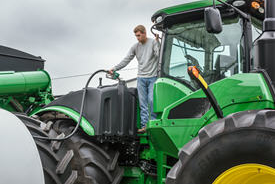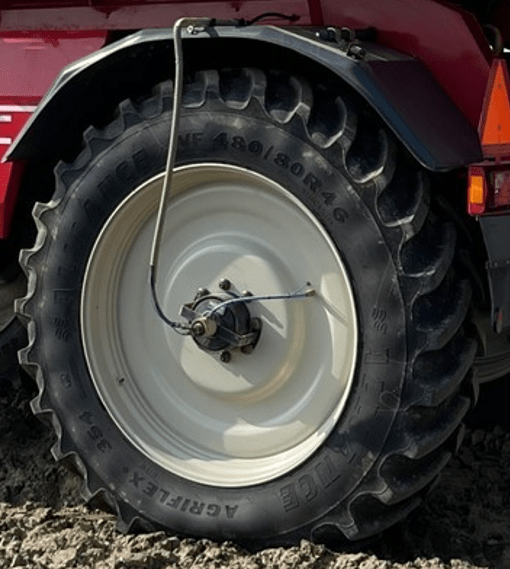CENTRAL TIRE INFLATION SYSTEM Fuel Savings
BKT USA, Inc.
Dave Paulk: Manager Field Technical Services
CTIS Accommodates Field & Road
Central air inflation systems on tractors and combines are starting to be more widely considered and used. A compressor mounted on the tractor and air lines connected to the tires allow for air pressures to be dropped in the field and air to be added to the tires before road use. This can ensure that tires are used with the proper air pressure for the application. Incorrect air pressures for diverse applications can cause a variety of problems with the tires, including premature wear, tire casing failures, and impact breaks. Correct air pressures can save time, fuel, and money.
Yokohama Off-Highway Tires America, Inc.
Blaine Cox: National Product Manager—Agriculture, Golf and Turf
When diesel prices are as high as they have been this season, a central tire inflation system (CTIS)—which allows you to adjust inflation pressure on the go, right from the cab—can pay itself off more quickly than ever. And not only does CTIS improve fuel economy, it also helps you get longer wear and better performance out of your tires.

CTIS enables Optimum Field vs Road PSI
Maxam Tire International
Greg W. Gilland: Business Development & Ag Segment Manager
| Best Practice | Suggested Activity | Expected Benefit or Result |
| Managing Tire Inflation & Maintenance | The pressurized air in the tire cavity carries 80% of the axle or vehicle weight, therefore, air pressure management has a direct impact on how the machine operates. Adjusting the working air pressure by axle load will ensure the best possible tire footprint, reduce tire slip, and improve traction equaling improved fuel efficiency. New Machinery with onboard air pressure monitoring and inflation adjustment systems allows for constant air pressure optimization based on axle load and speed. | Underinflation or overinflation can increase fuel consumption by creating greater rolling resistance, whereas constantly managed air pressures either manually or through onboard inflation systems could save over 15% on fuel consumption in 1 year, all by reducing slip which increases traction (tire footprint), resulting in improved productivity and fuel savings. |
Michelin Ag
David Graden: Operational Market Manager – Agriculture
Central Tire Inflation System
Finally, you could even take one more step toward total efficiency and invest in a Central Tire Inflation System (CTIS) by Michelin owned PTG. This proven technology allows an operator to run most Michelin tires down as low as 6 psi (depending on the weight of the machine) in the field, which maximizes footprint and traction, then up to the tire’s maximum air pressure for road speeds, which reduces rolling resistance and improves stability at higher speeds. In either case, applying this technology could earn you up to 10% fuel savings! Now, couple that with the proven 4% gain in yield from reduced soil compaction and you’re adding tens of thousands back to your bottom line! To add the cherry on top, these systems can be transferred from one machine to another, as your trade cycle dictates.
At Michelin, we train and equip every one of our sales reps with the tools and skills to properly ballast and recommend air pressures specific to your application and needs. Don’t hesitate to reach out to your local Michelin sales representative now, for further information, and at no additional costs: https://agtiretalk.com/technicalcontacts/
Precision Inflation Systems
Ken Brodbeck: VP of Technology
Like to Cut Your Fuel Bill by 5 to 10%? Changing Tire Pressures is the Answer!

On our 1200 grain farm, the fuel bill was a painful necessity. My guess is the same is true on your operation.
-
-
- Setting tire pressure on your Ag. machines is just as important as setting your combine correctly for either corn or soybeans.
- If the combine is not set just right, grain/money goes out the back end. The same is true for your tires. Fuel is wasted with too much pressure in the field, along with yield loss from soil compaction. And tires wear out and/or fail early if they are set too low.
-
What to Do?
- Check the tractor companies’ suggested ballast recommendations for your machine’s task. Planting will be lighter than heavy tillage in the fall. Ballast and adjust tire pressures accordingly.
- Weigh each axle so you can set the tire pressure per the tire manufacturer’s minimum pressure for the heaviest condition. Typically, this is the road transport.
- Your soil, tillage practices and hills may call for more ballast. How do you tell what is the right ballast?
- Wheel slip for radials should be in the 8 to 12% range for the best fuel efficiency. Sounds high right? Wrong! A lot of tractors are running consistently at 2 to 3% slip. The trouble is at 2% to 3% slip you are are burning extra fuel just to drag the tractor up and down hills while creating more soil compaction. Not Good.
- Lighten the tractor, especially for planting and possibly even grain cart work. If the slip goes up to 15% climbing one steep hill in the field, no problem and your fuel bill will thank you.
- Why raise tire pressure for the road? Per a University of California Davis fuel economy test with standard tires, not IF or VF, they showed fuel economy improvements on the road of 7.3% for + 7 psi and 11.4% for + 14 psi above the standard minimum pressure!!
- Europe has been using Central Tire Inflation (CTI) for over 30 years. This gives you the best of both worlds. High pressure for better fuel economy over the road and lowest pressure for the maximum traction and fuel efficiency along with minimizing soil compaction and increasing yield 2 to 4%.
- 200 bushel corn x 6 $/bushel x 2% = an extra $24 per acre!
- 24 x1000 acres = $ 24,000 per year. You may be losing $ 24K with high tire pressures in yield alone!
- Bottom line: Investing in a tire inflation system on tractor and planter can pay for itself in 1 to 2 years on yield alone, not including fuel and tread wear savings.
Contact us at Precision Inflation, we can help: https://agtiretalk.com/technicalcontacts/
Trelleborg Wheel Systems
Chris Neidert: Marketing, Training and Development Manager – AG
CTIS (Highly Recommended)
As tire professionals, in most ag tire applications, we recommend the ideal environment for an ag tire is one air pressure (lower) in the field and another air pressure (higher) on the road. Central Tire Inflation Systems (CTIS) can provide this option. Running multiple air pressures can provide many benefits – bigger footprint in the field for less compaction – more tread on the ground for more traction – more tread on the ground for better wear and a smoother ride. On the road, a more stable tire for handling and better road wear.
Firestone Ag
Austin Fischer: Firestone Ag Field Engineer
Implement a Central Tire Inflation System (CTIS): A CTIS system allows the operator to run the optimal pressure, both in the field and on the road, to unlock maximum wear performance, improve traction and reduce fuel use due to less tire slip.
Let’s consider a grower who uses a 36-row semi-mounted planter. When it’s raised up and in its transport configuration, this adds a significant amount of weight to the tractor’s rear axle. However, when it’s in the field planting, most of that weight will no longer be on the tractor, but on the soil. With a CTIS system, the grower can reduce the inflation pressure of the tires on the rear axle on-the-fly to maintain the optimal footprint. A tractor without CTIS will need to maintain the pressure required for transporting the planter even though it may be significantly more than what is needed at the time.
All information is provided in this blog solely to provoke thought. All deductions made from information on this site must be confirmed by Certified Ag Tire Dealer before use. Ag Tire Talk does not recommend anyone conduct tire service work with exception of Certified Ag Tire Dealer Professionals.

